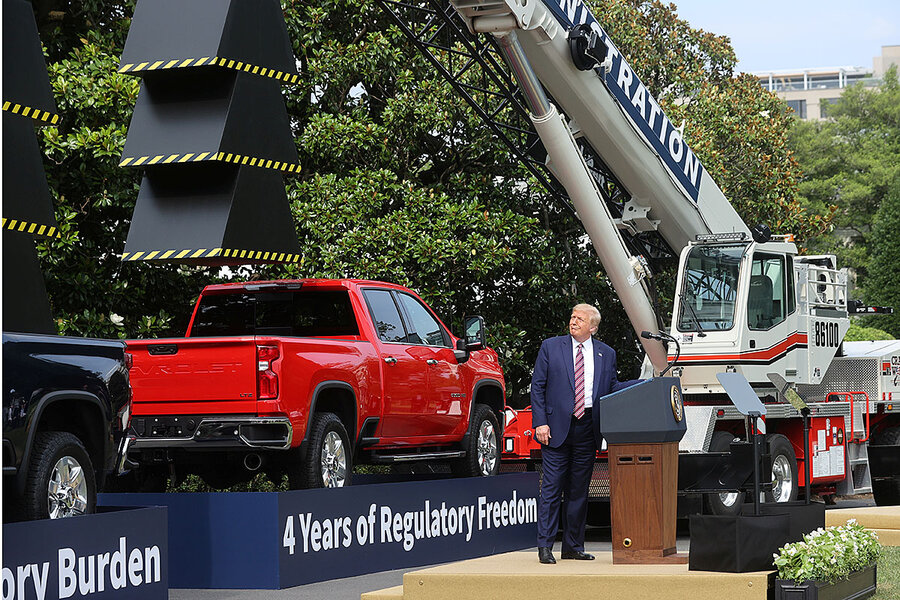Trump’s environmental rollbacks: A four-year tide of regulatory change
Loading...
| Washington
Days after entering office, President Donald Trump made a promise: He would eliminate two rules for every one signed into existence. Since then, he has sought to make good on that pledge and more – touting his reversal of a “regulatory assault” on the economy and individual liberty.
But it has come with controversy, with many Americans disagreeing with moves that have been particularly sweeping in the arena of environmental policy. More than 100 rollbacks have been launched over issues as diverse as toxic substances, energy extraction, and Environmental Protection Agency (EPA) efforts to combat climate change. The graphics with this story explore the trends (click the “deep read” to see them all).
Why We Wrote This
The trend of government regulation is perennially one of rising volume. The Trump administration is trying mightily to bend that curve downward – resulting in clashes over economic liberty and protecting Earth’s climate.
Some legal experts say that the changes, while often resting on shaky scientific ground, could in some cases leave a lasting legacy – undermining the leeway of future environmental policymakers to set a different course.
“They’re advancing these regulatory changes that create more flexibility,” says Caitlin McCoy, a staff attorney at Harvard Law School’s environmental and energy law program. “But in the process they’re trying to ... reduce EPA’s authority well into the future to ever try to come back under a new administration.”
Days after entering office, President Donald Trump made a promise: He would eliminate two rules for every one signed into existence.
Since then, he has sought to make good on that pledge and more – touting his reversal of a “regulatory assault” on the economy at a White House event on July 16, saying, “The American people know best how to run their own lives.”
Although many Americans have praised the president’s deregulation efforts, many disagree with a loosening of rules that has been particularly sweeping in the arena of environmental policy. As the graphics with this story illustrate, more than 100 rollbacks have been launched, over issues as diverse as toxic substances, energy extraction, and Environmental Protection Agency (EPA) efforts to combat climate change.
Why We Wrote This
The trend of government regulation is perennially one of rising volume. The Trump administration is trying mightily to bend that curve downward – resulting in clashes over economic liberty and protecting Earth’s climate.
Some legal experts say that the changes, despite often resting on shaky scientific ground, could in some cases leave a lasting legacy – undermining the leeway of future environmental policymakers to set a different course.
“They’re advancing these regulatory changes that create more flexibility, but in the process they’re trying to ... reduce EPA’s authority well into the future to ever try to come back under a new administration,” says Caitlin McCoy, a staff attorney at the Harvard Law School’s environmental and energy law program.
When the EPA replaced the Obama-era Clean Power Plan with the Affordable Clean Energy rule last June, it not only marked a momentous win for Mr. Trump’s deregulatory project. It also finalized a narrower meaning for the phrase “best system of emissions reductions” for the country’s power plants. The administration’s new legal interpretation could be tricky to undo, says Ms. McCoy.
If elected president, Joe Biden would “have to confront the fact that, a year earlier, the same agency said they didn’t have that authority” to mandate cleaner electricity, she says. Administrations may change, “but through the lens of administrative law, it’s the EPA, and it’s supposed to have a certain amount of consistency all the way through.”
Other experts have questioned the analyses used to justify these rollbacks. The Government Accountability Office recently released a report detailing how the EPA and other agencies have dramatically understated the “social cost of carbon,” the costs to society of greenhouse gas emissions that spur climate change. The EPA’s own scientists disavowed arguments justifying another major Trump rollback, the Safer Affordable Fuel-Efficient (SAFE) Vehicles rule. The change, replacing Obama-era fuel economy targets for new cars, is projected to add emissions equal to an extra 5 million cars on the road by 2025 alone, according to federal forecasts. A typical car today emits about 4.6 metric tons of carbon dioxide per year.
In some cases, Trump administration efforts are hitting delays and possibly brick walls. The Administrative Procedure Act requires that a new rule must have a “reasoned explanation” for it to be sound – or withstand a lawsuit, says Bethany Davis Noll of the Institute for Policy Integrity at New York University School of Law.
“The facts show that [SAFE] is harmful,” says Ms. Davis Noll. “And so [the EPA] is doing shoddy stuff monkeying with the numbers to try to get away from that conclusion.”
If some Trump moves leave a lasting mark, in other cases the president’s actions could face reversals – notably in cases where his policies lack strong economic or scientific footing. “I think most presidents want some kind of legacy,” Ms. Davis Noll says, and in her view “that’s what he hasn’t managed to accomplish.”











